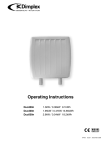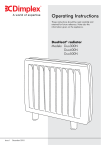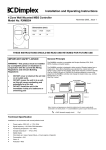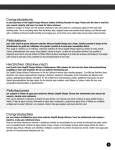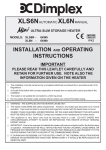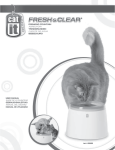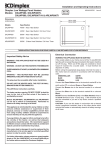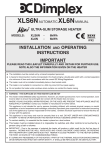Download Dimplex Duo300N Operating instructions
Transcript
Installation Instructions Duo300n Duo400n Duo500n 1.3kW / 0.38kW 9.1kWh 1.95kW / 0.47kW 13.65kWh 2.6kW / 0.54kW 18.2kWh 87452 -1- Issue 1 : December 2008 A A Circuit Diagram B Charge Control Thermostat C Limit Thermostat D StorageHeater Elements F Room Sensing Thermistor G Core Sensing Thermistor H Controller PCB I User Display J Peak Supply K Radiant Element L Live N Neutral P Pilot Wire E Manual Fit Connector L1 Live Storage In L2 Live Storage Out L3 Live Radiant In L4 Live Radiant Out S1 Signal In S2 Signal Out N1 Neutral Out N2 Neutral Out M -2- Off Peak Supply Dimensions (including clearances diagram) (millimetres) Wymiary (w tym schemat minimalnych odlegđoħci) (w milimetrach) Dimensioni (incluso lo schema degli spazi liberi) (millimetri) Dimensiones (milímetros) Dimensões (milímetros) D E B 75mm min. G 250mm min. 75mm min. C 150mm min. A F 110mm Model Modelo Modelo Modello Model Height Altura Altura Altezza Wys. Duo300i Duo400i 712mm 712mm 600mm 830mm 130mm+10mm 130mm+10mm Duo500i 712mm 1060mm 130mm+10mm A Width Ancho Comprimento Larghezza Szer. Depth Profundidad Profundidad Profondità Gleb. B C D Curtains E Shelf or Overhang Estantería u objetos Prateleira ou objectos Ripiano o sporgenza en suspensión em suspensão Póđka lub czúħè wystajæca F Furniture or other obstruction Mueble o cualquier obstrucción Mobília ou outra obstrução Mobile o altro oggetto Meble lub inne elementy G Wall Pared, cortinas o muebles Parade,cortinasou mobília Parete, tende o mobili Ħciany, firanki lub meble Cortinas Cortinas -3- Tende Firanki 1 5 1 2 1 6 1. Feet 2. Accessories Bag 1. Patas 2. Bolsa de accesorios 1. Pés de apoio 2. Saco de acessóries 1. Piedini 2. Sacchetto accessori 1. Nogo 2. Worek z akcesoriami 2 2 1 2 1 4 10A 10mm 10B -4- 10F 10E 11A 30mm 1. 11c 11D 6. 2. 5. 7. 4. 3. 1. Brick 2. 8mm Drill 3. 3” No. 10 Screws (supplied) 4. Length +15mm 1. Ladrillo 2. 8mm Ø 3. Incluye tornillos 3” No. 10 4. Longitud del taco +15mm 1. Tijolo 2. 8mm Perfurar 3. 3” No. 10 parafusos (fornacidos) 4. Comprimento da bucha +15mm 1. Mattone 2. Punta da 8mm 3. Inserti in fibra n. 10 (in dotazione) 4. Lunghezza inserto +15mm 1. Cegla 2. Wierto 8mm 3. 3” No. 10 4. Dđugoħè kođka rozporowego +15mm 5. Plaster 6. Low density block 7. Special fixing 5. Yeso 6. Pared blanda 7. Fijaciones especiales 5. Gesso 6. Bloco de Baixa Densidade 7. Fixação especial 5. Intonaco 6. Blocchi a bassa densità 7. Dispositivo di fissaggio speciale 5. Tynk 6. Material o mæđej gústoħci 7. Plastikowy kođek rozporowy. -5- 12A 12B 12C 13 14 15A 16 15B -6- 18 18A 18B 19A 19B 19C 19D 19E 19F 1 2 -7- English THESE INSTRUCTIONS SHOULD BE READ CAREFULLY AND RETAINED FOR FUTURE REFERENCE NOTE ALSO THE INFORMATION GIVEN ON THE APPLIANCE TO ENSURE THIS APPLIANCE IS OPERATING CORRECTLY, IT IS ESSENTIAL TO PERFORM THE CHECK PROCEDURE DETAILED ON THE BACK PAGE OF THIS INSTRUCTION. THIS MUST BE COMPLETED BEFORE NORMAL OPERATION COMMENCES. IMPORTANT SAFETY ADVICE WARNING - This radiator is VERY HEAVY, it is essential that the radiator is FIXED SOUNDLY TO A WALL and mounted on a FIRM, LEVEL SURFACE. WARNING – Choose the appropriate fixings to securely attach the radiator to the wall; Suggested Wall Fittings (see page 5 for further information) Solid brick/block: Size 10 plastic inserts (provided). 8mm drill bit. Drill 15mm deeper than insert length. Plasterboard: If possible locate studding and use No. 10 woodscrews directly into the wood, otherwise M5 intersets. For other wall types seek specialist advice. WARNING – If during any reassembly of the radiator, a part of the thermal insulation shows damage or deterioration which may impair safety, it should be replaced with an identical part. WARNING – This radiator must not be located below a fixed socket outlet. WARNING - in order to avoid overheating, do not cover the radiator. DO NOT COVER OR OBSTRUCT the surfaces of the appliance. DO NOT POSITION under windows where curtains may contact the radiator (see minimum clearances on Page 3). DO NOT PLACE OBJECTS in contact with the radiator. DuoHeat Radiators are not suitable for installation in bathrooms, shower rooms etc. or in areas of high humidity. Electrical Connection WARNING – THIS APPLIANCE MUST BE EARTHED The installation of this appliance should be carried out by a competent electrician in accordance with I.E.E. Regulations for Electrical Equipment. The radiator is fitted with two flexible cables for connection to the fixed wiring of the premises through suitable connection boxes positioned adjacent to the radiator. Each supply circuit to the radiator must incorporate a double pole isolating switch having a contact separation of at least 3mm. This radiator is not suitable for connection to a 30A ring circuit. ATTENTION : IN ORDER TO AVOID OVER HEATING DO NOT COVER THE HEATER Energy Retention Cells Energy retention cells are supplied separately to the radiator in packs of two. The reference number is 85743. Duo300i 8 Cells (4 Packs) Duo400i 12 Cells (6 Packs) -8- Duo500i 16 Cells (8 Packs) INSTALLATION OF THE RADIATOR ASSEMBLY 7. Ensure the electronic components are not damaged when removing the panel. Carefully place the panel to one side. Check that the mains supply cables are not damaged. If they are to be replaced only heat resistant cable must be used (min. T85) for both the off peak cable and peak. Refer to sections 3, 19 and 20 for fitting the off peak and radiant element cables. 1. Open carton from the bottom. Remove feet and accessories bag from the polystyrene packaging. (Fig. 1) 2. Before removing the radiator from the carton, fit the feet to the radiator by engaging the flanges on the top of the foot with the slots in the base of the radiator 1 . Push the foot towards the back of the radiator until it is fully engaged 2 . (Fig. 2) 8. Position radiator against wall in intended final position, ensuring it is on a firm base and taking note of the minimum fixing dimensions (see page 3). 3. The direct acting mains cable is clipped to the underside of the radiator ensuring it is secure during transit. The off peak mains cable will be secured with cable ties. Prior to installing the radiator, unclip the direct acting mains cable (do not remove or discard these clips). 9. If the floor is carpeted it is important that the feet are positioned firmly and securely. The feet may rest on top of the carpet, however carpet gripper should be removed around the feet so that the radiator rests in a level position. NOTE: If the off peak mains connection is required to be made on the right hand side of the radiator, the pre-wired cable must be passed behind the feet and secured using the clips on the base of the radiator. For ease of access this should be done while the radiator is still upside down in the carton. Similarly when the direct acting mains cable is ready to be connected (See Section 19), if the connection is required to be made on the left hand side of the radiator the cable must be routed behind the feet. DO NOT clip the direct acting mains cable at this stage (See Section 19). The cable clips are already fitted at the factory to allow both mains cables to be attached, if required. WALL MOUNTING The following must be applied before fixing the radiator to the wall: NO SKIRTING BOARD / SKIRTING BOARD NO TALLER THAN 100MM 10A The radiator is to be mounted as shown in Fig. 10A, with the wall spacer bracket in its standard orientation. 10B Mark the position of the two mounting slots with the radiator pushed tight against the wall Fig. 10B. Drill holes into the wall toward the bottom of the marked slots. 4. Stand the radiator on its feet and remove packaging. Remove all additional internal protective packaging. (Fig. 4) 10C 5. Stand the radiator on its feet and against a wall. Remove the securing screws along the bottom edge of the front panel. (Fig. 5) Use the 10mm spacers provided (4 x 10mm) between the rear of the radiator and the wall. DO NOT use the 30mm spacers where there are no skirting boards or they are no taller than 100mm. 10D 6. Carefully swing bottom of panel slightly away from the rest of the radiator 1, thus disconnecting the radiant element connector from the front panel, and lift upwards to unhook the top edge 2 . (Fig. 6). 10E -9- Place one 10mm spacer to the inside and another 10mm spacer to the outside of the location hole on the back panel (see Fig 10A for wall spacer bracket orientation). Carefully guide the radiator towards the drilled hole and screw part way to the wall Fig. 10E. Panelled internal walls DO NOT USE 30MM SPACER ON INSIDE OF RADIATOR. If possible, locate the studding and use No. 10 size woodscrews. Where it is not possible to locate the studding use type M5 Rawlplug INTERSETS on securely fastened plasterboard panelling. For other wall materials the wall panel manufacturer should be consulted for details of suitable wall fixing devices. USE ONLY EXTERNALLY - SEE FIG. 11A. NOTE: UNDER NO CIRCUMSTANCES SHOULD THESE SCREWS BE REMOVED WITHOUT FIRST REMOVING 12. Remove the inner front panel by removing the screws along its top edge Fig. 12A. Carefully lift the bottom of the front inner panel out of the retaining flange at the base of the radiator, Fig 12B and remove the internal packaging, Fig. 12C taking care not to damage the insulation attached. ALL ENERGY RETENTION CELLS FROM THE RADIATOR 10F Once both sides have been successfully positioned screw the radiator flush to the wall Fig. 10F. Do not fully tighten these screws until the core has been loaded into the radiator as some settling of the radiator may occur. 13. Lift out the elements from the base insulation and rotate forwards. Fig. 13. DO NOT DISCONNECT THE TERMINALS 11. SKIRTING BOARD TALLER THAN 100MM 14. Carefully fit the bottom row of the back layer of energy retention cells, placing the two end cells in position first with the flat side toward the back. Fit the top row of cells also with the recess toward the element. Fig. 14 Use the 10mm and 30mm spacers provided (2 x 10mm and 2 x 30mm) 11A 11B If the skirting board is taller than 100mm, the radiator is to be mounted as shown in fig 11A. Remove the wall mounting bracket and reassemble in the alternative orientation to give a greater spacing distance from the wall. 15. Refit the elements by carefully feeding the tails down through the hole in the base insulation, ensuring the tab is pointing forward. Fit the front layer of cells with the flat side toward the front of the radiator. Ensure that the tab on the element is captured below the bottom row of cells and that the element is vertical. Fig. 15A & 15B. Place the 30mm spacer to the outside of the radiator and the 10mm to the inside. Drill the holes as detailed in Section 10. Carefully guide the radiator towards the drilled hole. When in position screw part way to the wall to secure the radiator as in Section 10, remembering not to fully tighten the screws. 16. Replace the inner front complete with insulation by locating its bottom edge behind the front lip of the chassis and inserting the retaining screws along the top and both sides. Fig. 16. 17. Check that the screws securing the radiator to the wall have been fully tightened. It is essential that all screws are replaced to ensure earth continuity. Solid brick/High density block walls - Fig. 11C These must be drilled and plugged with the No. 10 size plastic inserts provided. The correct size of drill (8mm) should be used and the hole should be drilled to a depth of 15mm greater than the length of the plastic insert so that the fixing is made below the plaster layer. Once installed DO NOT attempt to reposition the radiator without first unloading the energy retention cells and obtaining the services of a competent electrician. Low density block walls - Fig 11d A special fixing, such as Unifix LB70 should be employed, following closely the manufacturers instructions. - 10 - RADIANT ELEMENT OVERRIDE 18. In its factory default setting, the radiant element will be allowed to operate for up to 2 hours after the beginning of the off peak charge period to maintain a comfortable room temperature if required. After 2 hours the radiant element will be automatically disabled until the end of the off peak charge period. In circumstances where it will not be necessary to maintain a high ambient room temperature between the hours of typically 12am and 2am (for example a commercial application) this feature can be disabled by removing the time delay pin on the power enable board (see Fig. 18A), which will automatically switch the radiant element off at the beginning of the off peak charge period. The BLACK pilot wire is designed to carry a signal from a compatible remote programming device. If, however, a remote programmer is not being used, the appliance may be connected to the fixed wiring of the premises simply by cutting back the BLACK pilot wire, ensuring that it terminates within the outer insulating sheath of the supply cable. DO NOT connect the BLACK PILOT WIRE to earth. When the programmer drives other radiators, connect the pilot wires together in series. Any 240V insulated cable may be used to link pilot wires around the ring main. A low signal current is used. Suitable connections would be either an additional single core wire marked or colour coded appropriately or use a 4 core cable throughout the radiator ring. As a mains conductor, the pilot wire should be isolated in accordance with the IEE regulations. The ability to ‘lock’ the controls eg. school conditions, is achieved by removing the pin shown in Fig. 18B, which will prevent appliance settings being altered. For further details of connection to Dimplex programming devices, please refer to the relevant Dimplex programmer instructions. REASSEMBLY 19. Reconnect the radiant element connector as shown in Fig 19A-19F. Replace the outer front panel by hooking onto the two location clips on the top panel Fig. 19B, 19C & 19E. Swing the bottom of the front panel gently towards the radiator Fig. 19F until the radiant element connector is securely placed at the base of the radiator Fig. 19D. REPLACING MAINS WIRE ON DIRECT ACTING SUPPLY CIRCUIT HEAT RESISTING CABLE MUST BE USED (MIN. T85) ON NO ACCOUNT SHOULD ANY SURPLUS CABLE BE PUSHED INSIDE OR BEHIND THE RADIATOR. CHECK ALL ELECTRICAL CONNECTIONS FOR TIGHTNESS. ELECTRICAL CONNECTION IMPORTANT 20. The wires in the direct acting supply cable are coloured in accordance with the following code: GREEN & YELLOW: EARTH BLUE: NEUTRAL BROWN: LIVE BLACK: PILOT WIRE - 11 - CHECK PROCEDURE FOR INSTALLERS FOLLOWING INSTALLATION THIS CHECK PROCEDURE SHOULD BE CARRIED OUR BY A COMPETENT INSTALLER ONLY. THE OPERATING INSTRUCTIONS ARE AVAILABLE FOR END USERS. DuoHeat has a built in self diagnostic function that enables both service engineers and end users to diagnose faults. Make sure that the peak supply is on before starting the diagnostic function. Adjust the LED’s down until only the blue frost protection LED is illuminated. Press and hold the button for 10 seconds until the blue LED goes off then release the button. The LED’s will now come on one at a time - this indicates that the radiator is running the diagnostic checks. A flashing LED will then illuminate to indicate a pass or fail. - 2. To check the radiant panel operation (comfort heat). (i) Adjust the temperature control display as follows; press down the button until all red bars are illuminated (shown below). After 2 minutes the front panel should now feel warm, this will confirm correct operation. + - Pass - 8th LED flashes - if Delta Dor is not connected or in Comfort Mode. (ii) If the front panel does not heat up and room temperature is below 26°C, remove front panel and ensure there is no damage to front panel or radiant element and that all electrical connections are secure. If front panel is still not heating up, phone customer help line. Pass - 9th LED flashes - if Delta Dor is in Setback mode. NOTE: Fault Conditions If room temperature is above 26°C, radiator will not operate. IMPORTANT 1st Red LED flashing - Room temperature sensor fault. Once radiator has been confirmed as fully operational, use Page 2 of the ‘Operating Instructions’ to set up initial customer settings. 2nd Red LED flashing - Core temperature sensor fault. Please ensure the “Operating Instructions” are left with the radiator for user information. 3rd Red LED flashing - Radiant Panel temperature fault. Contact Customer Helpline if any of the above faults are detected. - 12 -














